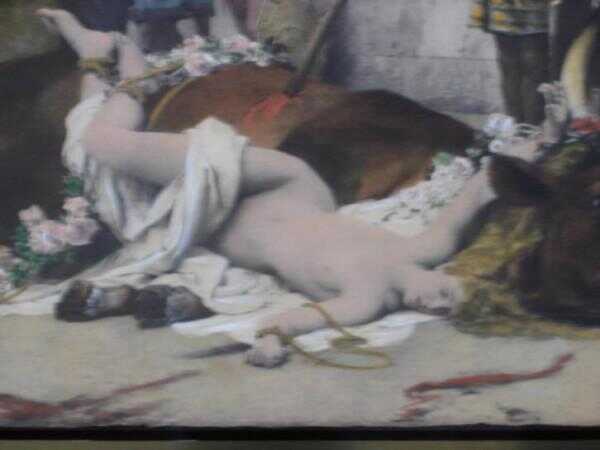Home > Antiek en Kunst > Kunst - Etsen en Gravures
Antieke ingekleurde ets Henryk Siemiradzki +/- 1900
Beschrijving
Antieke ingekleurde ets Henryk Siemiradzki +/- 1900Prachtige ingekleurde ets van het werk Henryk Siemiradzki [ 1843-1902 ]
Afm : ets 38x78cm / 62x99,5cm incl lijst
Lijst uit de jaren 30 heeft wat rand beschadigingen / glas 100% in orde
Gekocht bij : Kunsthandel P Visé / Grote Berg Eindhoven
sticker op achterzijde.
ORGINEEL
Titel : Christian Dirce
Jaar : 1897
Sign : H.SIEMIRADZKI PINX. A.D.MDCCCXCVII / .ROMA
Afm : orginele schilderij 263x530 cm
Plaats : Nationale Museum in Warsaw
Er is veel info te vinden over deze Poolse schilder op internet
Ik heb alvast wat info onderaan de advertentie geplaatst.
MAIL ME UW BOD en als dat redelijk is krijgt u zeker antwoord van mij [ VANAF prijs €175,00]
OPHALEN HEEFT MIJN VOORKEUR !!!!
Bekijk al mijn aanbiedingen KLIK OP DAAN en er zal een wereld voor u open gaan vol RETRO en veel MOOIE en APARTE SPULLEN
No 2373
Extra info :
Henryk Hektor Siemiradzki (24 October 1843 23 August 1902) was a Polish painter, best remembered for his monumental Academic art. He was particularly known for his depictions of scenes from the ancient Graeco-Roman world and the New Testament, owned by national galleries of Poland, Russia and Ukraine.[1][2]
Many of his paintings depict scenes from antiquity, often the sunlit pastoral scenes or compositions presenting the lives of early Christians. He also painted biblical and historical scenes, landscapes, and portraits. His best-known works include monumental curtains for the Lviv (Lwów) Theatre of Opera and for the Juliusz Sowacki Theatre in Kraków (below).
Biography[edit]
Siemiradzki was born to a Polish noble szlachta family of an officer (since 1871 a General) of the Imperial Russian Army, Hipolit Siemiradzki, and Michalina (nee Prószyska)[3] in the village of Bilhorod (Biaogród),[1][4] or Novobelgorod (now Pechenegi, sources vary)[2] near the city of Kharkov in the Russian Empire, where his father's regiment was stationed.[5] The family had origins in Radom land and derived its name from the village of Siemiradz. One of the branches settled in the late 17th century near Navahrudak (Nowogródek). Henryk's grandfather held the post of podkomorzy in Nowogródek powiat. His parents were close friends with Adam Mickiewicz's family. He studied at Kharkov Gymnasium where he first learned painting under the local school teacher, D.I. Besperchy, former student of Karl Briullov. He entered the Physics-Mathematics School of Kharkov University and studied natural sciences there with great interest, but also continued to paint.[3]
After graduating from the University with the degree of Kandidat he abandoned his scientific career and moved to Saint Petersburg to study painting at the Imperial Academy of Arts in the years 18641870. Upon his graduation he was awarded a gold medal. In 18701871 he studied under Karl von Piloty in Munich on a grant from the Academy. In 1872 he moved to Rome and with time, built a studio there on Via Gaeta, while spending summers at his estate in Strzakowo near Czstochowa in Poland.
In 1873 he received the title of Academician of the Imperial Academy of Arts for his painting Christ and a Sinner, based on a verse from Tolstoy. In 1878 he received the French National Order of the Legion of Honour and a Gold Medal of the Paris World's fair for the painting Flower vase. In 18761879 Siemiradzki worked on frescoes for the Cathedral of Christ the Saviour (Moscow) among his other large-scale projects. In 1879 he offered one of his best-known works, the enormous Pochodnie Nerona (Nero's torches), painted around 1876, to the newly formed Polish National Museum. The artwork is on display at the Siemiradzki Room of the Sukiennice Museum in the Kraków Old Town, the most popular branch of the museum today. Around 1893 Siemiradzki worked on two large paintings for the State Historical Museum (Moscow) and in 1894 produced his monumental curtain for the Juliusz Sowacki Theatre in Kraków.[2]
He died in Strzakowo in 1902 and was buried originally in Warsaw, but later his remains were moved to the national Pantheon on Skaka in Kraków.
Advertentie






